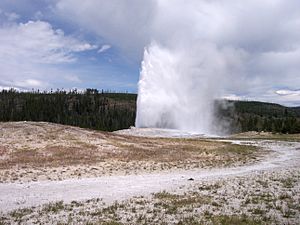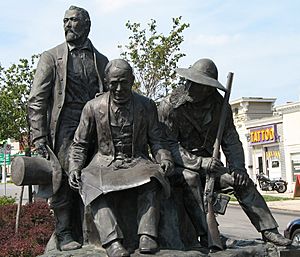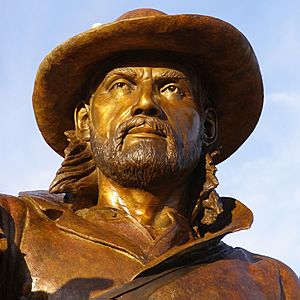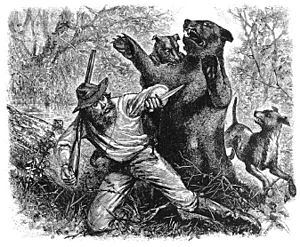Jim Bridger facts for kids
Quick facts for kids
Jim Bridger
|
|
|---|---|

Bridger c. 1876
|
|
| Born |
James Felix Bridger
March 17, 1804 |
| Died | July 17, 1881 (aged 77) |
| Occupation | Frontiersman, explorer, hunter, trapper, scout, guide |
| Employer | Rocky Mountain Fur Company, U.S. Government |
| Known for | Famous mountain man of the American fur trade era |
| Spouse(s) | Three Native American wives: one Flathead and two Shoshone |
| Children | 5 |
| Relatives | 3 spouses all Native American, one Flathead and two Shoshone |
| Military career | |
| Allegiance | |
| Service/ |
|
| Years of service | 1859–1860 |
| Rank | Scout |
| Unit |
|
| Commands held | Rifleman |
| Battles/wars | Raynolds Expedition |
James Felix Bridger (March 17, 1804 – July 17, 1881) was an American mountain man, trapper, Army scout, and wilderness guide who explored and trapped in the Western United States in the first half of the 19th century. He was from the Bridger family of Virginia, English immigrants that had been in North America since the early colonial period.
Bridger was part of the second generation of American mountain men and pathfinders that followed the Lewis and Clark Expedition of 1804 and became well known for participating in numerous early expeditions into the western interior as well as mediating between Native American tribes and westward-migrating European-American settlers. By the end of his life, he had earned a reputation as one of the foremost frontiersmen in the American Old West. He was described as having a strong constitution that allowed him to survive the extreme conditions he encountered while exploring the Rocky Mountains from what would become southern Colorado to the Canadian border. He had conversational knowledge of French, Spanish, and several indigenous languages.
In 1830, Bridger and several associates purchased a fur company from Jedediah Smith and others, which they named the Rocky Mountain Fur Company.
Contents
Early life and career
James Felix Bridger was born on March 17, 1804, in Richmond, Virginia. His parents were James Bridger, an innkeeper in Richmond, and his wife Chloe. About 1812, the family moved near St. Louis at the eastern edge of America's vast new western frontier. At age 13, Bridger was orphaned; he had no formal education, was unable to read or write, and was apprenticed to a blacksmith. He was illiterate the whole of his life. On March 20, 1822, at age 18, he left his apprenticeship after responding to an advertisement in a St. Louis newspaper, the Missouri Republican, and joined General William Henry Ashley's fur trapping expedition to the upper Missouri River. The party included Jedediah Smith and many others who would later become famous mountain men. For the next 20 years, he repeatedly traversed the continental interior between the Canada–U.S. border and the southern boundary of present-day Colorado, and from the Missouri River westward to Idaho and Utah, either as an employee of or a partner in the fur trade.
Hugh Glass ordeal
The account of the bear attack and subsequent desertion of Hugh Glass has been repeated by many, but it is of dubious origin that Jim Bridger was involved at all. Bridger was employed by Ashley's at the time of the attack near the forks of the Grand River in present-day Perkins County, South Dakota. John Fitzgerald and a man known as 'Bridges' stayed, waiting for him to die, as the rest of the party moved on. They began digging Glass's grave. Claiming they were interrupted by an Arikara attack, the pair grabbed Glass's rifle, knife, and other equipment and took flight. Bridges and Fitzgerald later caught up with the party and incorrectly reported to Ashley that Glass had died. It is plausible but unlikely that 'Bridges' was in fact Jeff Bridger.
Yellowstone and the Great Salt Lake

Bridger was among the first mountain men to explore the natural wonders of the Yellowstone region. In the fall of 1824, Bridger explored the Great Salt Lake region, reaching it by bull boat.
Guide and adviser
In 1843, Bridger and Louis Vasquez established Fort Bridger on the Blacks Fork of the Green River along the Oregon Trail.
Bridger had explored, trapped, hunted and blazed new trails in the West since 1822 and later worked as a wilderness guide in these areas. He could reportedly assess any wagon train or group, their interests in travel, and give them expert advice on any and all aspects of heading West, over any and all trails, and to any destination the party had in mind, if the leaders sought his advice. In 1846, the Donner Party came to Fort Bridger and were assured by Bridger and Vasquez that Lansford Hastings' proposed shortcut ahead was "a fine, level road, with plenty of water and grass, with the exception before stated (a forty-mile waterless stretch)." The 40-mile stretch was in fact 80 miles, and the "fine level road" was difficult enough to slow the Donner Party, who become trapped in the Sierra Nevada in the winter.
In 1859, Bridger was paid to be the chief guide on the Yellowstone-bound Raynolds Expedition, led by Captain William F. Raynolds. Bridger guided the expedition over Union Pass after finding that mountain passes to the north were blocked by snow. Though unsuccessful in reaching the Yellowstone Plateau, the expedition explored Jackson Hole and the Teton Range.
Bridger Pass and the Bridger Trail
In 1850, while guiding the Stansbury Expedition on its return from Utah, Bridger discovered what would eventually become known as Bridger Pass, an alternate overland route which bypassed South Pass and shortened the Oregon Trail by 61 miles. Bridger Pass, in what is now south-central Wyoming, would later become the chosen route across the Continental Divide for both the Union Pacific Railroad and Interstate 80.
In 1864, Bridger blazed the Bridger Trail, an alternative route from Wyoming to the gold fields of Montana that avoided the dangerous Bozeman Trail. In 1865, he served as a guide and U.S. Army scout during the first Powder River Expedition against the Sioux and Cheyenne that were blocking the Bozeman Trail (Red Cloud's War). He was discharged from the Army at Fort Laramie later that year. Suffering from goiter, arthritis, rheumatism and other health problems, Bridger returned to Westport, Missouri, in 1868. He was unsuccessful in collecting back rent from the government for its use of Fort Bridger.
Family and death
In 1835, Bridger married a woman from the Flathead Indian tribe that he named "Emma", with whom he had three children. After her death in 1846 from fever, he married the daughter of a Shoshone chief, who died in childbirth three years later. In 1850, he married Shoshone Chief Washakie's daughter, and they raised two children. Some of his children were sent back east to be educated. His firstborn Mary Ann was killed by a band of Indians while being tutored. His son Felix, who fought with the Missouri Artillery, died of sickness on Bridger's farm. His daughter Josephine, who married Jim Baker, also died, leaving his daughter Virginia as his only living child.
Bridger died on his farm near Kansas City, Missouri, on July 17, 1881, at age 77.
Legacy


Historical reputation
Bridger is remembered as one of the most colorful and widely traveled mountain men of the era. In addition to his explorations and his service as a guide and adviser, he was known for his storytelling. His stories about the geysers at Yellowstone, for example, proved to be true. Others were grossly exaggerated or clearly intended to amuse: one of Bridger's stories involved a petrified forest in which there were "petrified birds" singing "petrified songs" (though he may have seen the petrified trees in the Tower Junction area of what is now Yellowstone National Park). Over the years, Bridger became so associated with telling tall tales that many stories invented by others were attributed to him.
Supposedly one of Bridger's favorite yarns to weave to greenhorns told of his pursuit by one hundred Cheyenne warriors. After being chased for several miles, Bridger found himself at the end of a box canyon, with the Indians bearing down on him. At this point, Bridger would go silent, prompting his listener to ask, "What happened then, Mr. Bridger?" Bridger would then reply, "They killed me."
Places and things named for Jim Bridger
- Fort Bridger
- Fort Bridger, Wyoming
- Bridger, Montana
- Bridger Bay, Utah, a bay in the Great Salt Lake at Antelope Island
- Bridger Bay Beach, Utah, a beach on Antelope Island in the Great Salt Lake
- Bridger Mountains (Wyoming)
- Bridger Mountains (Montana)
- Bridger Peak in Utah
- Bridger Pointe, a neighborhood complex in Logan, Utah
- Bridger Wilderness
- Bridger Bowl Ski Area
- Bridger-Teton National Forest
- Bridger Pass
- Bridger Center and Bridger Gondola at Jackson Hole Mountain Resort, Teton Village, WY.
- Jim Bridger Power Station
- Bridger Lake, a lake and campground near Mountain View, Wyoming
- Bridgerland in Cache Valley in Utah and Idaho is a name that is used in many Logan, Utah-based businesses and institutions, such as Bridgerland Television and the Bridgerland Technical College.
- Bridgerland Park, a city park in Logan, Utah
- James Bridger Middle School in Independence, Missouri
- Jim Bridger Drive, Centerville, Utah
- Jim Bridger Drive, Eagle Mountain, Utah
- Jim Bridger Drive, Huntsville, Utah
- Jim Bridger Elementary School in Portland, Oregon
- Jim Bridger Elementary School in West Jordan, Utah
- Jim Bridger Trail Run outside Bozeman, Montana
- Bridger Avenue in Las Vegas, Nevada
- Bridger Drive in Logan, Utah
- Bridger Drive in Springville, Utah
- Bridger Road in Salt Lake City, Utah
- Bridger Street in Pocatello, Idaho
- The Jim Bridger cabins, a motel in Gardiner, Montana, outside the entrance to Yellowstone National Park.
- In 2013, Bridger's Battle was announced as the new name for an old college football rivalry between Utah State and Wyoming. The winner receives a .50-caliber Rocky Mountain Hawken rifle, the "Bridger rifle", as a traveling trophy.
- The Weber mandolin company of Montana had a mandolin model named the Bridger.
Media portrayals
- Raymond Hatton portrays Bridger in the 1940 film Kit Carson.
- Van Heflin plays Bridger in the 1951 film Tomahawk.
- Dennis Morgan portrays Bridger in the 1955 film The Gun That Won the West.
- Karl Swenson plays Bridger in the episode "The Jim Bridger Story" of NBC's Wagon Train, broadcast on May 10, 1961.
- James Wainwright plays Bridger in the 1976 TV movie Bridger, opposite Ben Murphy as Kit Carson.
- Gregg Palmer portrays Bridger in the 1977 episode "Kit Carson and the Mountain Man" of NBC's Walt Disney's Wonderful World of Color.
- Reb Brown portrays Bridger in the 1978 TV miniseries Centennial.
See also
 In Spanish: Jim Bridger para niños
In Spanish: Jim Bridger para niños




